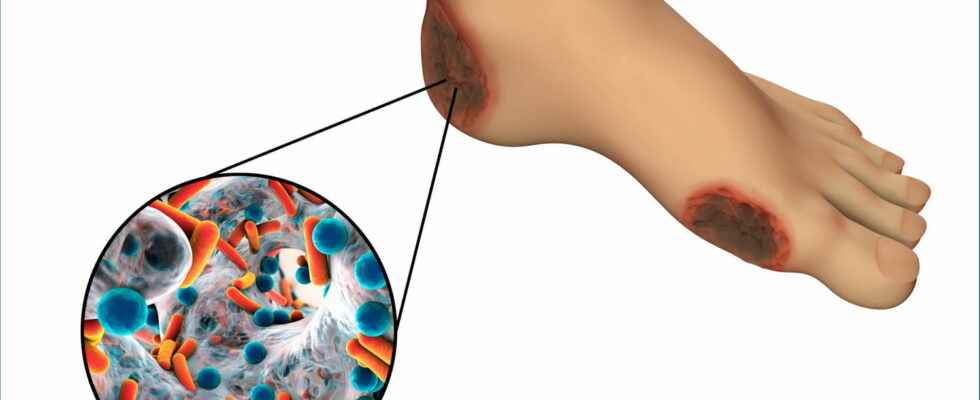Gangrene refers to the destruction of tissue due to prolonged slowing or cessation of arterial blood flow. De Fournier, gassy, diabetic, on the foot… Typical symptoms of gangrene and treatments.
Definition
Gangrene is a condition that corresponds to cell death (necrosis) up to a Part of the body, most often a limb or an organ (heart, liver, lungs, etc.). It is enough that the blood circulation is stopped in an area (blocked artery, infection) for gangrene to develop: deprived of oxygen, the organic tissues putrefy.
Fournier’s gangrene
Fournier’s gangrene is a serious condition characterized by rapid and progressive necrosis of the perineum and genitals external. There is often a local infectious, traumatic or surgical triggering factor. Contributing factors, such as age, diabetes and immunosuppression, are often present in affected patients. “Management is urgent and requires prolonged parenteral antibiotic therapy, hydroelectrolyte rebalancing and trimming of necrotic tissue”, explains Dr. Philippe Boidin, vascular surgeon.
Gas gangrene
Gas gangrene, also called “putrid emphysema” or “myonecrosis”, is a microbial infection with Clostridium perfringens type A (anaerobic bacterium). This bacterium produces gas within the infected tissue. This results in a crackling sensation, sometimes perceptible when palpating the affected areas.
Dry gangrene and wet gangrene
One distinguishes in particular the “dry gangrene” where the fabrics often appear black and mainly due to the interruption of blood flow by a clogged artery, and the “wet gangrene” dominated by the presence of weeping tissues in putrefaction. The ideal is to intervene before the stage of gangrene: nevertheless in advanced cases, the restoration of a correct circulation may not be sufficient and an amputation may be necessary.
Diabetic gangrene
People with diabetes are at greater risk of developing gangrene. It is estimated that the risk of gangrene in diabetics is multiplied by 17 compared to that of the non-diabetic population. This risk is 10 times higher after the age of 65 years. In France, diabetes is responsible for 10,000 amputations per year. In question: the loss of sensitivity caused by the scarcity of nerve fibers at the level of the extremities.
Foot gangrene: what to do?
“She is in most cases due to a blood circulation problem, reminds our interlocutor. The flesh is no longer sufficiently irrigated.” As soon as the first signs of damage to the skin tissues are observed, a vascular assessment should be carried out as soon as possible, including a Doppler echo and one CT angiography to identify clogged arteries. “Depending on the results, clogged or clogged vessels will be dilated or replaced with an artificial artery (vascular prosthesis).”
Symptoms of gangrene
The symptoms most often associated with gangrene are:
- stiffness and visible swelling in the affected part
- loss of sensitivity and significant pain in the gangrenous area
- the appearance of blisters, even ulcers
- cold, pale skin over the affected area
- In some cases, the affected limb may feel heavy and a cracking of the skin may be akin to it.
As part of an infectious origin, other signs may also appear:
- a feverish state
- loss of appetite
- increased heart rate (tachycardia) and breathing
- dizziness and vertigo
“Without proper care and treatment, the affected tissue will begin to die, insists our interlocutor. The affected area will then change color from white to darker and darker red to gradually darken. The risks in the event of absence of treatment are: a generalized infection, a extension of gangrene to the rest of the member concerned, and even death. “This dramatic development has become rare these days due to the appropriate and rapid management of patients.”
Causes of gangrene
Gangrene can occur after surgery, in the context of an infection or if the patient has a pathology related to blood circulation problems.
“It is in most cases due to a blood circulation problem.”
Gangrene Treatments
The faster the management of the gangrene and the faster the appropriate treatment is put in place, the less the amputation risks are here.
- As part of an infection, theantibiotic therapy is usually associated with the treatment of gangrene.
- As part of a consequent gangrene, thesurgical act is generally necessary, initially in order to revascularize the affected area. In a second, in the context of amputation.
With current methods of treatment, the majority of gangrene victims survive, although most suffer loss of muscle tissue. It is possible to reduce the chances of such complications by carefully cleaning the wounds with the antisepticwatching for signs of pusof rednessswelling or unusual pain and seeking medical attention for any wounds that may become infected.
Made with Dr Philippe Boidin, vascular surgeon at the Pays de Savoie private hospital in Annemasse.
